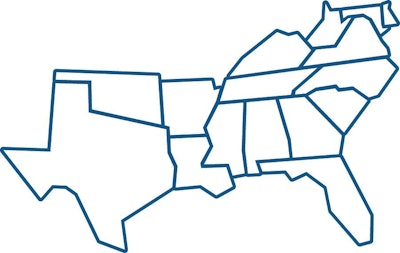 Southern Regional Education Board (SREB) member states
Southern Regional Education Board (SREB) member states
“It is troubling to say the least,” said Dr. Stephen Pruitt, president of SREB. “We’re now trying to bounce back from a pandemic, and we’re seeing the job market shifting to all or most livable wage careers requiring some postsecondary degrees. If we continue down the road that we’re on, where people are not engaging in postsecondary education, then we may see a lot of people who are unemployable by 2030.”
SREB states include Alabama, Arkansas, Delaware, Florida, Georgia, Kentucky, Louisiana, Maryland, Mississippi, North Carolina, Oklahoma, South Carolina, Tennessee, Texas, Virginia, and West Virginia.
SREB’s Fact Book on Higher Education and 16 individual state data reports point to how enrollment in two-year colleges between 2014 and 2019 fell by roughly 7% in SREB states compared to 11% nationwide. Some states saw nearly a 20% drop in that same time.
According to recent data from the National Student Clearinghouse, two-year college enrollment then dropped by 15% nationwide in fall 2020, followed by an estimated one-year decline of 7.8% in fall 2021.
“We’re looking at a national crisis right now,” said Dr. Jason Lane, dean of the College of Education, Health, and Society at Miami University in Ohio, referring to recent higher education trends in the country overall. “When we see fewer students coming into higher education, that has a long-term, potentially negative impact on our ability as a nation to be competitive, to innovate, and to continue to lead the world around issues of research and development. For a lot of reasons, we should be paying attention to this right now.”
By 2030, SREB also found that dependent groups—those who are under age 25 or older than 64, thus not part of the primary workforce—are expected to reach 53% of the SREB region’s population. These groups would outnumber working-age adults, making the potential toll of college enrollment declines on the workforce particularly urgent.
“We do know that your best bet is still to get a bachelor’s degree,” said Dr. Anthony Carnevale, professor and director of the Georgetown University Center on Education and the Workforce, who noted that a college degree remains key to better paid careers in the long run. “The BA is still the engine on the train."
The reports also revealed that the total enrollment of Hispanic students rose from 16% to 20% from 2014 to 2019 at public and private two-year and four-year higher education institutions in SREB states. And over that same time period, two-year college enrollment among Hispanic students in SREB states jumped by 19.4%, higher than the 11% national increase.
“I’m not fully surprised by that,” said Dr. Deborah Santiago, co-founder and CEO of Excelencia in Education, a nonprofit focused on accelerating Latino student success in higher education. “When you look at the overall growth of the Hispanic population over the last 10 to 12 years, especially in SREB states, we have been making up a greater part of the K-12 school population. The challenge I see is that the pandemic disproportionately negatively impacted our community. These numbers could have been even higher today had it not been for the last two years.”
The reports additionally found overall college enrollment among Black students in SREB states declined from 22% in 2014 to 20% in 2019. These figures include both four-year and two-year as well as public and private higher education institutions. Over that same period, two-year college enrollment of Black students fell by 21% nationwide—and there was a 18.6% drop, amounting to about 116,000 students, in SREB states.
“This is a very urgent public policy issue,” said Dr. Stella Flores, associate professor of higher education and public policy at the University of Texas at Austin. “These SREB states are more likely to have Black high school graduates than most of the rest of the country, and yet not enough Black students are enrolling in college in these states. We had better numbers in the early 2000s than we do now. And now with COVID, I would call this a public health crisis in that Black individuals are the group most likely to have dealt with death as a result of the pandemic. So, these are numbers before the death and trauma of COVID. I am really concerned.”
As to some of the reasons why fewer people are enrolling, Dr. Stevie Lawrence II, vice president of higher education at SREB, noted the rising cost of college. In addition, the worth of a degree is not being communicated clearly enough, he pointed out.
“I think it is important for those of us working at postsecondary institutions to ensure that the return on investment is illuminated and amplified,” said Lawrence. “And that we connect that information to students and families as much as we can. Because there is data that shows if you attain an associate’s degree, BA, or any form of postsecondary education, you will over time earn more than a person who only has a high school credential.”
To Pruitt at SREB, all hands must be on deck to solve such problems moving forward.
“We actually can’t afford to think about just the postsecondary aspect of this,” said Pruitt. “We need to think about the whole system, starting in K-12 schools and moving all the way through adult education into the workforce. And we need people in postsecondary education to understand the opportunities ahead of them. How do we get more people to graduate with credentials or degrees of value?”
Rebecca Kelliher can be reached at [email protected].
















